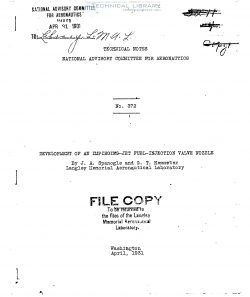naca-tn-372
- Version
- 127 Downloads
- 571.79 KB File Size
- 1 File Count
- November 24, 2016 Create Date
- November 24, 2016 Last Updated
National Advisory Committee for Aeronautics, Technical Notes - Development of an Impinging Jet Fuel Injection Valve Nozzle

During an investigation to determine the possibilities and
limitations of a two—stroke—cYcle engine with fuel injection
and spark ignition, it was necessary to develop a fuel—injection
valve nozzle to produce a disk-shaped, well—dispersed.spray.
Preliminary tests.showed that two smooth jets impinging upon.-
each other at-an angle of 74 degrees gave a spray with-the.de—‘
sired-characteristics. Nozzles were built on this_basis and,
when used_in fuel—injection valVes, produced a spray-thattfule.
filled'the original requirements. The spray is so well_dis— .
parsed that it can be carried along with an air stream of com-
paratively low velocity or entrained with the fuel jet from a
roundrhole orifice. This characteristic of the spray from an
impingingejet nozzle limits_its_application to situations where
wide dispersion is required by the conditions in_the engine cyl—
inder and the cemhustion chamber.
The staff of the National Advisory Committee for Aeronautics
at the Langley Memorial Aeronautical Laboratory has undertaken
the investigation of the possibilities and limitations of the
two—stroke—cycle high—speed fuel-ingestion engine as a means for
increasing the power per unit of displacement obtainable from an
engine suited to aircraft use. For this investigation it was
desirable to have an engine capable of covering a wide range of 4
experimental conditions. This requirement made the design of
the fuel—injection valve and nozzle, as well as other accessory
parts for this engine, a rather difficult problem.
The cylinder for this engine had been decided upon before
the design of the fuel—injection valve Was started and had four
holes that could be used for the fuel—injection valve or valves.
These holes were in pairs diametrically opposed; one hole of the
first pair in either side of the combustion chamber and the other
pair similarly arranged in the cylinder wall just above the air—
admission ports so that the fuel could be injected into the air
stream as it entered the cylinder. As this air flow could be
controlled to be either radial or tangential to the cylinder,
the spray had to be nearly circular in shape, perpendicular to
the axis of the cylinder, and, at the same time, well dispersed.
For the radial flow with injection into the combustion chamber,
the residual air flow is negligible and the movement of the_oil
must be depended upon for proper distribution. For tangential
flow the residual velocity in the combustion chamber is low and
therefore the spray must be well dispersed to obtain proper dis—
tribution. For either type of air flow, with injection through
the lower cylinder wall holes, the spray must be well dispersed
to follow this air flow and produce a proper mixture of fuel and
air (internal carburetion).
| File | Action |
|---|---|
| naca-tn-372 Development of an Impinging Jet Fuel Injection Valve Nozzle.pdf | Download |

Comment On This Post